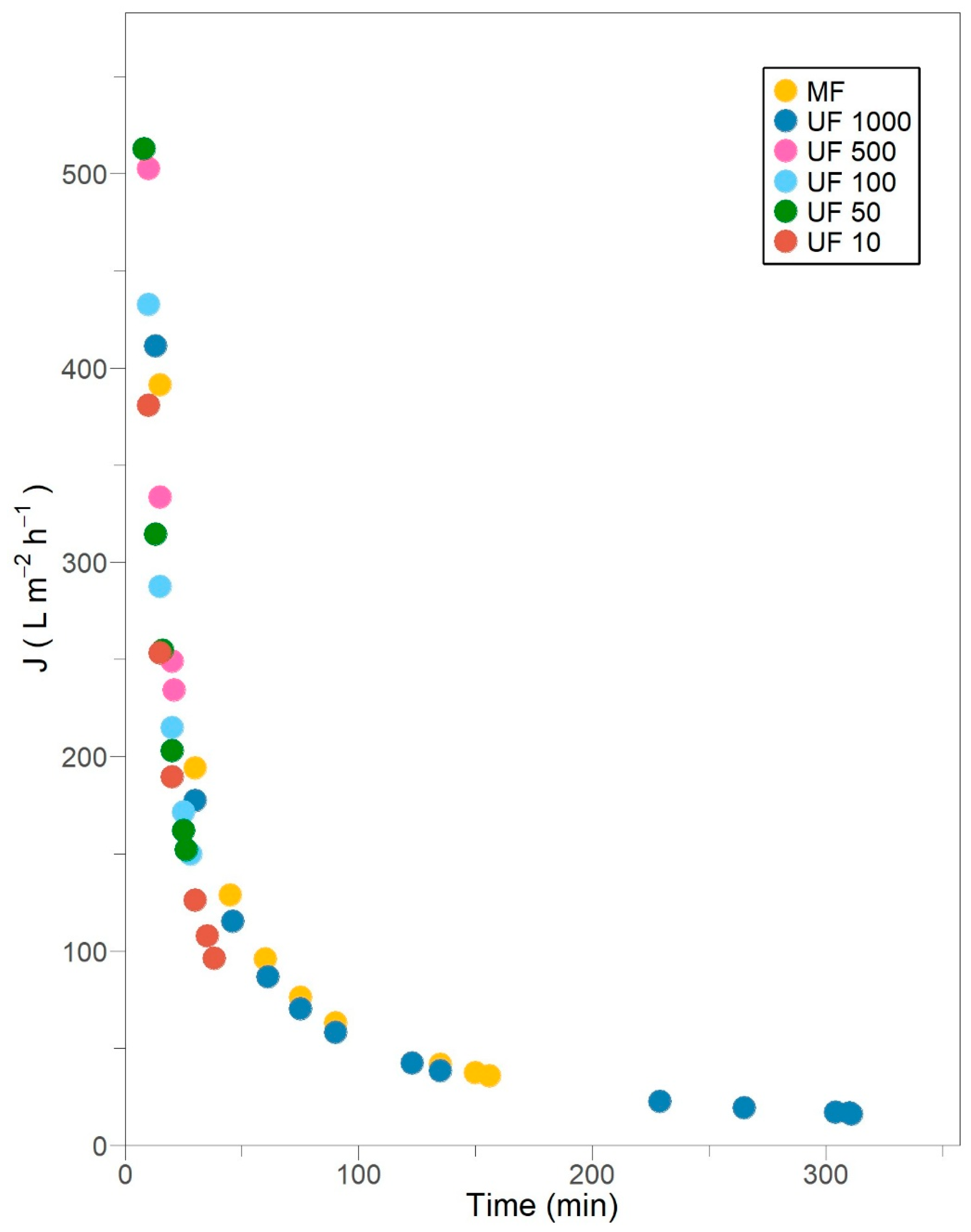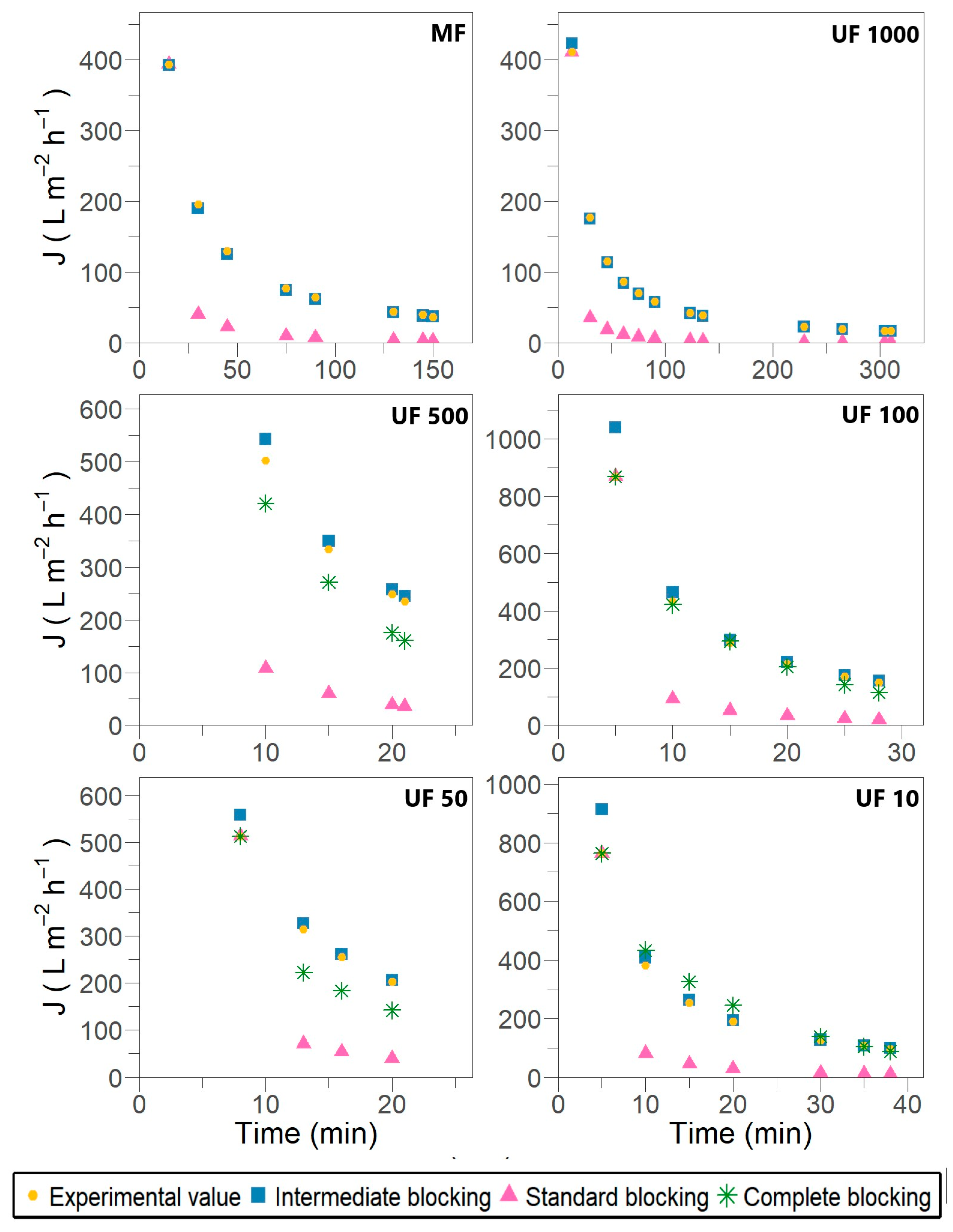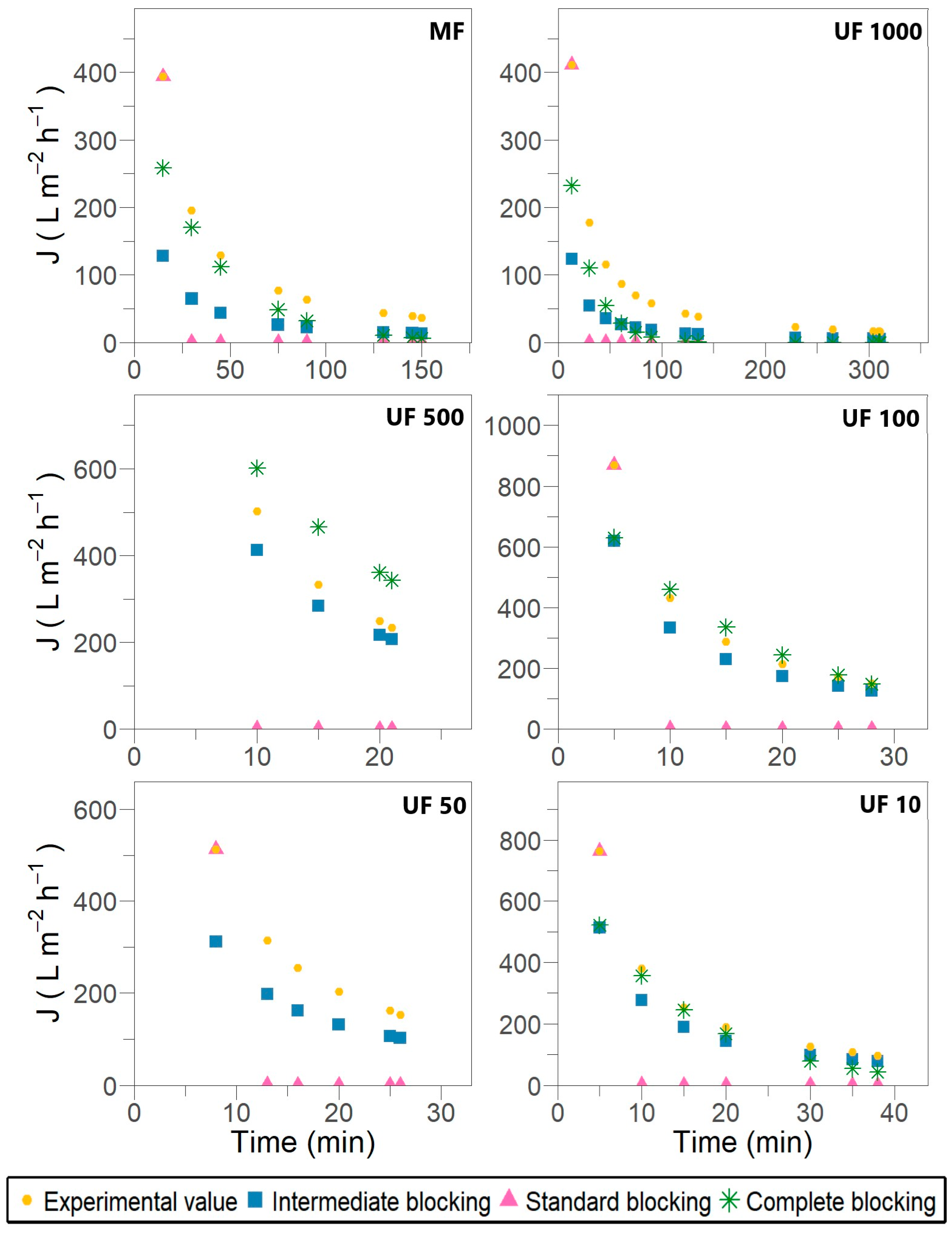A Model-Driven Approach to Assessing the Fouling Mechanism in the Crossflow Filtration of Laccase Extract from Pleurotus ostreatus 202
Abstract
1. Introduction
2. Materials and Methods
2.1. Microorganisms and Laccase Extract Production
2.2. Filtration Experiments
2.3. Laccase Extract Characterization
2.3.1. Laccase Activity, Protein Concentration and Specific Activity
2.3.2. Filtration Performance Parameters
2.3.3. Molecular Weight Determination
2.4. Membrane-Fouling Models
3. Results and Discussion
3.1. Laccase Production and Filtration
3.2. Dynamic Permeate Flux Profile in Constant-Pressure Filtration
3.3. Analysis of Membrane-Fouling Mechanisms Applied to Crossflow Laccase Filtration
3.3.1. Complete Pore Blocking with Allowance for Crossflow Removal (n = 2)
3.3.2. Intermediate Pore Blocking with Allowance for Crossflow Removal (n = 1)
3.3.3. Pore Filling or Conventional Standard Pore Blocking (n = 1.5)
3.4. Degree of Membrane Fouling
3.5. Conclusions
Supplementary Materials
Author Contributions
Funding
Institutional Review Board Statement
Data Availability Statement
Acknowledgments
Conflicts of Interest
Abbreviations
| Laccase activity in retentate | |
| Laccase activity in feed | |
| Retentate volume | |
| Initial extract volume | |
| Specific activity of retentate | |
| Specific activity of feed | |
| Permeate flux at time t | |
| Permeate volume collected | |
| Membrane area | |
| Time of sampling | |
| Permeate volume per unit membrane area | |
| Initial permeate volume | |
| Steady-state flux related to crossflow removal from surface | |
| Blocking constant for standard dead-end filtration mechanism | |
| Blocking constant for standard crossflow filtration mechanism | |
| Blocking constant for intermediate dead-end filtration mechanism | |
| Blocking constant for intermediate crossflow filtration mechanism | |
| Blocking constant for complete dead-end filtration mechanism | |
| Blocking constant for complete crossflow filtration mechanism | |
| Blocking constant for cake formation dead-end filtration mechanism | |
| Blocking constant for cake formation crossflow filtration mechanism | |
| Maximum permeate volume |
References
- Liu, S.; Li, Z.; Yu, B.; Wang, S.; Shen, Y.; Cong, H. Recent Advances on Protein Separation and Purification Methods. Adv. Colloid Interface Sci. 2020, 284, 102254. [Google Scholar] [CrossRef] [PubMed]
- Tanudjaja, H.J.; Anantharaman, A.; Ng, A.Q.Q.; Ma, Y.; Tanis-Kanbur, M.B.; Zydney, A.L.; Chew, J.W. A Review of Membrane Fouling by Proteins in Ultrafiltration and Microfiltration. J. Water Process Eng. 2022, 50, 103294. [Google Scholar] [CrossRef]
- Madsen, E.; Kaiser, J.; Krühne, U.; Pinelo, M. Single Pass Tangential Flow Filtration: Critical Operational Variables, Fouling, and Main Current Applications. Sep. Purif. Technol. 2022, 291, 120949. [Google Scholar] [CrossRef]
- Krippl, M.; Dürauer, A.; Duerkop, M. Hybrid Modeling of Cross-Flow Filtration: Predicting the Flux Evolution and Duration of Ultrafiltration Processes. Sep. Purif. Technol. 2020, 248, 117064. [Google Scholar] [CrossRef]
- Hao, Y.; Moriya, A.; Ohmukai, Y.; Matsuyama, H.; Maruyama, T. Effect of Metal Ions on the Protein Fouling of Hollow-Fiber Ultrafiltration Membranes. Sep. Purif. Technol. 2013, 111, 137–144. [Google Scholar] [CrossRef]
- Lay, H.T.; Yeow, R.J.E.; Ma, Y.; Zydney, A.L.; Wang, R.; Chew, J.W. Internal Membrane Fouling by Proteins during Microfiltration. J. Memb. Sci. 2021, 637, 119589. [Google Scholar] [CrossRef]
- Rajeeva, S.; Lele, S.S. Bioprocessing of Laccase Produced by Submerged Culture of Ganoderma Sp. WR-1. Sep. Purif. Technol. 2010, 76, 110–119. [Google Scholar] [CrossRef]
- Songulashvili, G.; Flahaut, S.; Demarez, M.; Tricot, C.; Bauvois, C.; Debaste, F.; Penninckx, M.J. High Yield Production in Seven Days of Coriolopsis Gallica 1184 Laccase at 50 L Scale; Enzyme Purification and Molecular Characterization. Fungal. Biol. 2016, 120, 481–488. [Google Scholar] [CrossRef]
- Zaccaria, S.; Boff, N.A.; Bettin, F.; Dillon, A.J.P. Use of Micro-and Ultrafiltration Membranes for Concentration of Laccase-Rich Enzymatic Extract of Pleurotus Sajor-Caju PS-2001 and Application in Dye Decolorization. Chem. Pap. 2019, 73, 3085–3094. [Google Scholar] [CrossRef]
- Ali, N.; Hassan, F.; Hamzah, S. Preparation and Characterization of Asymmetric Ultrafiltration Membrane for Effective Recovery of Proteases from Surimi Wash Water. Front. Chem. Sci. Eng. 2012, 6, 184–191. [Google Scholar] [CrossRef]
- Machado, J.R.; Severo, E.E.; de Oliveira, J.M.G.; Ores, J.C.; Brandelli, A.; Kalil, S.J. One-Step Ultrafiltration Process for Separation and Purification of a Keratinolytic Protease Produced with Feather Meal. Int. J. Chem. Eng. 2018, 2018, 6729490. [Google Scholar] [CrossRef]
- Singh, D.; Gupta, N. Microbial Laccase: A Robust Enzyme and Its Industrial Applications. Biologia 2020, 75, 1183–1193. [Google Scholar] [CrossRef]
- Khatami, S.H.; Vakili, O.; Movahedpour, A.; Ghesmati, Z.; Ghasemi, H.; Taheri-Anganeh, M. Laccase: Various Types and Applications. Biotechnol. Appl. Biochem. 2022, 69, 2658–2672. [Google Scholar] [CrossRef] [PubMed]
- Yang, J.; Li, W.; Ng, T.B.; Deng, X.; Lin, J.; Ye, X. Laccases: Production, Expression Regulation, and Applications in Pharmaceutical Biodegradation. Front. Microbiol. 2017, 8, 832. [Google Scholar] [CrossRef]
- Nguyen, L.N.; Vu, M.T.; Johir, M.A.H.; Pathak, N.; Zdarta, J.; Jesionowski, T.; Semblante, G.U.; Hai, F.I.; Khanh Dieu Nguyen, H.; Nghiem, L.D. A Novel Approach in Crude Enzyme Laccase Production and Application in Emerging Contaminant Bioremediation. Processes 2020, 8, 648. [Google Scholar] [CrossRef]
- Hou, B.; Chen, J.; Li, Y.; Liu, P.; Liu, Y.; Lu, J. Development of a Novel Model by Combining the Intermediate Blocking and Cake Filtration Models for Assessment of the Prevailing Fouling Mechanism in a Microbial Fuel Cell-Facilitated Membrane Bioreactor. AIP Adv. 2021, 11, 55218. [Google Scholar] [CrossRef]
- Hermia, J. Constant Pressure Blocking Filtration Law Application to Powder-Law Non-Newtonian Fluid. Trans. Inst. Chem. Eng. 1982, 60, 183–187. [Google Scholar]
- Field, R.W.; Wu, D.; Howell, J.A.; Gupta, B.B. Critical Flux Concept for Microfiltration Fouling. J. Memb. Sci. 1995, 100, 259–272. [Google Scholar] [CrossRef]
- Iritani, E.; Katagiri, N. Developments of Blocking Filtration Model in Membrane Filtration. KONA Powder Part. J. 2016, 33, 179–202. [Google Scholar] [CrossRef]
- Vela, M.C.V.; Blanco, S.Á.; García, J.L.; Rodríguez, E.B. Analysis of Membrane Pore Blocking Models Applied to the Ultrafiltration of PEG. Sep. Purif. Technol. 2008, 62, 489–498. [Google Scholar] [CrossRef]
- Vela, M.C.V.; Blanco, S.Á.; García, J.L.; Rodríguez, E.B. Analysis of Membrane Pore Blocking Models Adapted to Crossflow Ultrafiltration in the Ultrafiltration of PEG. Chem. Eng. J. 2009, 149, 232–241. [Google Scholar] [CrossRef]
- Duclos-Orsello, C.; Li, W.; Ho, C.-C. A Three Mechanism Model to Describe Fouling of Microfiltration Membranes. J. Memb. Sci. 2006, 280, 856–866. [Google Scholar] [CrossRef]
- Field, R.W.; Wu, J.J. Modelling of Permeability Loss in Membrane Filtration: Re-Examination of Fundamental Fouling Equations and Their Link to Critical Flux. Desalination 2011, 283, 68–74. [Google Scholar] [CrossRef]
- Wu, J.J. Improving Membrane Filtration Performance through Time Series Analysis. Discov. Chem. Eng. 2021, 1, 7. [Google Scholar] [CrossRef]
- Field, R.W.; Wu, J.J. Permeate Flux in Ultrafiltration Processes—Understandings and Misunderstandings. Membranes 2022, 12, 187. [Google Scholar] [CrossRef] [PubMed]
- Téllez-Téllez, M.; Fernández, F.J.; Montiel-González, A.M.; Sánchez, C.; Díaz-Godínez, G. Growth and Laccase Production by Pleurotus Ostreatus in Submerged and Solid-State Fermentation. Appl. Microbiol. Biotechnol. 2008, 81, 675–679. [Google Scholar] [CrossRef]
- Millipore Corporation. LabscaleTM Tangential Flow Filtration System User Guide; Millipore Corporation: Billerica, MA, USA, 2011. [Google Scholar]
- Flores, C.; Vidal, C.; Trejo-Hernández, M.R.; Galindo, E.; Serrano-Carreón, L. Selection of Trichoderma Strains Capable of Increasing Laccase Production by Pleurotus Ostreatus and Agaricus Bisporus in Dual Cultures. J. Appl. Microbiol. 2009, 106, 249–257. [Google Scholar] [CrossRef]
- Gornall, A.G.; Bardawill, C.J.; David, M.M. Determination of Serum Proteins by Means of the Biuret Reaction. J. Biol. Chem. 1949, 177, 751–766. [Google Scholar] [CrossRef]
- Antecka, A.; Blatkiewicz, M.; Boruta, T.; Górak, A.; Ledakowicz, S. Comparison of Downstream Processing Methods in Purification of Highly Active Laccase. Bioprocess Biosyst. Eng. 2019, 42, 1635–1645. [Google Scholar] [CrossRef]
- Laemmli, U.K. Cleavage of Structural Proteins during the Assembly of the Head of Bacteriophage T4. Nature 1970, 227, 680–685. [Google Scholar] [CrossRef]
- Tansel, B.; Bao, W.Y.; Tansel, I.N. Characterization of Fouling Kinetics in Ultrafiltration Systems by Resistances in Series Model. Desalination 2000, 129, 7–14. [Google Scholar] [CrossRef]
- Bryjak, J.; Rekuć, A. Effective Purification of Cerrena Unicolor Laccase Using Microfiltration, Ultrafiltration and Acetone Precipitation. Appl. Biochem. Biotechnol. 2010, 160, 2219–2235. [Google Scholar] [CrossRef] [PubMed]
- Abdelrasoul, A.; Doan, H.; Lohi, A.; Cheng, C.-H. Mass Transfer Mechanisms and Transport Resistances in Membrane Separation Process. In Mass Transfer-Advancement in Process Modelling; IntechOpen: London, UK, 2015; ISBN 9535121928. [Google Scholar]
- Kim, J.; DiGiano, F.A. Fouling Models for Low-Pressure Membrane Systems. Sep. Purif. Technol. 2009, 68, 293–304. [Google Scholar] [CrossRef]
- Zhang, Y.; Hess, H. Enhanced Diffusion of Catalytically Active Enzymes. ACS Cent. Sci. 2019, 5, 939–948. [Google Scholar] [CrossRef]
- Cirillo, A.I.; Tomaiuolo, G.; Guido, S. Microfiltration of Concentrated Albumin Solutions and the Role of Processing Conditions on Membrane Fouling. Chem. Eng. J. Adv. 2023, 16, 100561. [Google Scholar] [CrossRef]
- Ding, Y.; Wu, J.; Wang, J.; Lin, H.; Wang, J.; Liu, G.; Pei, X.; Liu, F.; Tang, C.Y. Superhydrophilic and Mechanical Robust PVDF Nanofibrous Membrane through Facile Interfacial Span 80 Welding for Excellent Oil/Water Separation. Appl. Surf. Sci. 2019, 485, 179–187. [Google Scholar] [CrossRef]
- Harouna, B.M.; Benkortbi, O.; Hanini, S.; Amrane, A. Modeling of Transitional Pore Blockage to Cake Filtration and Modified Fouling Index–Dynamical Surface Phenomena in Membrane Filtration. Chem. Eng. Sci. 2019, 193, 298–311. [Google Scholar] [CrossRef]
- Bowen, W.R.; Calvo, J.I.; Hernandez, A. Steps of Membrane Blocking in Flux Decline during Protein Microfiltration. J. Memb. Sci. 1995, 101, 153–165. [Google Scholar] [CrossRef]
- Kumar, R.; Ismail, A.F. Fouling Control on Microfiltration/Ultrafiltration Membranes: Effects of Morphology, Hydrophilicity, and Charge. J. Appl. Polym. Sci. 2015, 132, 42042. [Google Scholar] [CrossRef]
- Díaz, R.; Díaz-Godínez, G. Intracellular Isoforms of Laccases Produce by Pleurotus Ostreatus Grown in Liquid Fermentation at Different Initial PH of the Culture Medium. Mex. J. Biotechnol. 2019, 4, 38–50. [Google Scholar] [CrossRef]
- Armas-Tizapantzi, A.; Cuatecontzi-Cuautle, E.; Fernández, F.J.; Estrada-Torres, A.; Montiel-González, A.M. Temporal Profiles of Intra-and Extracellular Laccase Isoenzymes from Pleurotus Ostreatus Produced in Submerged and Solid-State Cultures. Afr. J. Biotechnol. 2016, 15, 1069–1077. [Google Scholar] [CrossRef]
- Zhong, C.; Wang, Z. A Three-Mechanism (Intermediate Pore Blocking, Standard Pore Blocking and Cake Filtration) Model Considering Correction of Effective Filtration Area. J. Environ. Chem. Eng. 2024, 12, 113654. [Google Scholar] [CrossRef]
- Slimane, F.Z.; Ellouze, F.; Ben Miled, G.; Ben Amar, N. Physical Backwash Optimization in Membrane Filtration Processes: Seawater Ultrafiltration Case. J. Membr. Sci. Res. 2018, 4, 63–68. [Google Scholar] [CrossRef]




| Pore-Blocking Mechanism | Dead-End Model | Crossflow Model |
|---|---|---|
| Standard blocking | ||
| Intermediate blocking | ||
| Complete blocking | ||
| Cake formation |
| Stage | V (mL) | Laccase (U/mL) | Protein (mg/mL) | SA (U/mg) | VCF | ACF | R (%) | PF |
|---|---|---|---|---|---|---|---|---|
| MF | 16.67 | 4.78 | 29 | 1.37 | ||||
| Initial extract | 500 | 0.217 | 0.08 | 2.70 | ||||
| Retentate | 30 | 1.038 | 0.28 | 3.70 | ||||
| UF 1000 | 10.44 | 2.04 | 20 | 1.49 | ||||
| MF permeate | 470 | 0.166 | 0.08 | 2.10 | ||||
| Retentate | 45 | 0.339 | 0.11 | 3.10 | ||||
| UF 500 | 28.33 | 0.80 | 3 | 1.79 | ||||
| UF 1000 permeate | 425 | 0.122 | 0.09 | 1.40 | ||||
| Retentate | 15 | 0.097 | 0.04 | 2.40 | ||||
| UF 300 | 26.67 | 0.89 | 3 | 0.89 | ||||
| UF 500 permeate | 400 | 0.114 | 0.07 | 1.60 | ||||
| Retentate | 15 | 0.101 | 0.07 | 1.40 | ||||
| UF 100 | 24.33 | 4.97 | 20 | 6.95 | ||||
| UF 300 permeate | 365 | 0.095 | 0.07 | 1.40 | ||||
| Retentate | 15 | 0.473 | 0.05 | 9.50 | ||||
| UF 50 | 23.00 | 5.33 | 23 | 3.20 | ||||
| UF 100 permeate | 345 | 0.071 | 0.06 | 1.20 | ||||
| Retentate | 15 | 0.379 | 0.10 | 3.80 | ||||
| UF 10 | 21.33 | 5.65 | 26 | 4.04 | ||||
| UF 50 permeate | 320 | 0.046 | 0.05 | 0.90 | ||||
| Retentate | 15 | 0.260 | 0.07 | 3.70 |
| Stage | Hermia’s Model | Field and Wu’s Model | |||
|---|---|---|---|---|---|
| R2 | Kb × 104 (m−1) | R2 | KbF × 104 (m−1) | JR (L/m2 h) | |
| MF | 0.922 | 2.58 | 0.939 | 4.64 | 59.39 |
| UF 1000 | 0.864 | 1.38 | 0.954 | 7.31 | 20.76 |
| UF 500 | 0.965 | 14.60 | 0.948 | 8.51 | 506.45 |
| UF 100 | 0.947 | 12.07 | 0.933 | 10.51 | 283.20 |
| UF 50 | 0.973 | 10.70 | 0.503 | 1.70 | 1248.08 |
| UF 10 | 0.932 | 9.47 | 0.932 | 12.60 | 157.19 |
| Stage | Hermia’s Model | Field and Wu’s Model | |||
|---|---|---|---|---|---|
| R2 | Ki (m−1) | R2 | KiF (m−1) | JR (L/m2 h) | |
| MF | 0.998 | 0.181 | 0.996 | 30.60 | 32.35 |
| UF 1000 | 0.999 | 0.196 | 0.989 | 36.50 | 18.74 |
| UF 500 | 0.999 | 0.204 | 0.979 | 13.50 | 452.00 |
| UF 100 | 0.999 | 0.238 | 0.972 | 16.70 | 325.87 |
| UF 50 | 0.999 | 0.254 | 0.989 | 22.40 | 197.95 |
| UF 10 | 0.999 | 0.271 | 0.962 | 20.30 | 230.84 |
| Stage | Hermia’s Model | Field and Wu’s Model | |||
|---|---|---|---|---|---|
| R2 | Ks (m−1) | R2 | KsF × 102 (s−0.5 m−0.5) | JR (L/m2 h) | |
| MF | 0.998 | 21.72 | 0.998 | 29.83 | 0.0049 |
| UF 1000 | 0.999 | 23.56 | 0.996 | 31.17 | 0.0034 |
| UF 500 | 0.999 | 24.46 | 0.993 | 21.21 | 0.0507 |
| UF 100 | 0.999 | 28.54 | 0.991 | 23.61 | 0.0362 |
| UF 50 | 0.999 | 30.42 | 0.997 | 28.18 | 0.0212 |
| UF 10 | 0.999 | 32.48 | 0.988 | 26.09 | 0.0253 |
Disclaimer/Publisher’s Note: The statements, opinions and data contained in all publications are solely those of the individual author(s) and contributor(s) and not of MDPI and/or the editor(s). MDPI and/or the editor(s) disclaim responsibility for any injury to people or property resulting from any ideas, methods, instructions or products referred to in the content. |
© 2025 by the authors. Licensee MDPI, Basel, Switzerland. This article is an open access article distributed under the terms and conditions of the Creative Commons Attribution (CC BY) license (https://creativecommons.org/licenses/by/4.0/).
Share and Cite
Páez, M.A.; Casa-Villegas, M.; Naranjo-Moreno, V.; Félix, N.E.; Cabezas-Terán, K.; Andreatta, A. A Model-Driven Approach to Assessing the Fouling Mechanism in the Crossflow Filtration of Laccase Extract from Pleurotus ostreatus 202. Membranes 2025, 15, 226. https://doi.org/10.3390/membranes15080226
Páez MA, Casa-Villegas M, Naranjo-Moreno V, Félix NE, Cabezas-Terán K, Andreatta A. A Model-Driven Approach to Assessing the Fouling Mechanism in the Crossflow Filtration of Laccase Extract from Pleurotus ostreatus 202. Membranes. 2025; 15(8):226. https://doi.org/10.3390/membranes15080226
Chicago/Turabian StylePáez, María Augusta, Mary Casa-Villegas, Vanesa Naranjo-Moreno, Neyda Espín Félix, Katty Cabezas-Terán, and Alfonsina Andreatta. 2025. "A Model-Driven Approach to Assessing the Fouling Mechanism in the Crossflow Filtration of Laccase Extract from Pleurotus ostreatus 202" Membranes 15, no. 8: 226. https://doi.org/10.3390/membranes15080226
APA StylePáez, M. A., Casa-Villegas, M., Naranjo-Moreno, V., Félix, N. E., Cabezas-Terán, K., & Andreatta, A. (2025). A Model-Driven Approach to Assessing the Fouling Mechanism in the Crossflow Filtration of Laccase Extract from Pleurotus ostreatus 202. Membranes, 15(8), 226. https://doi.org/10.3390/membranes15080226







